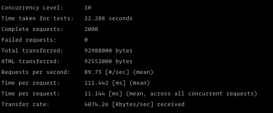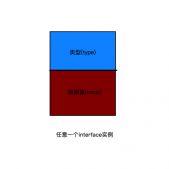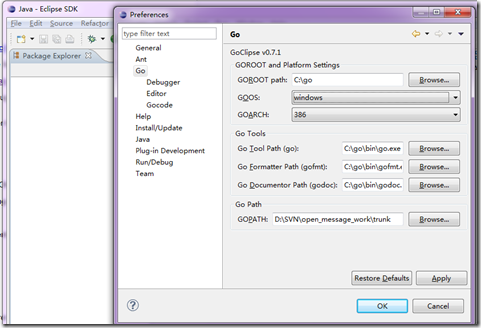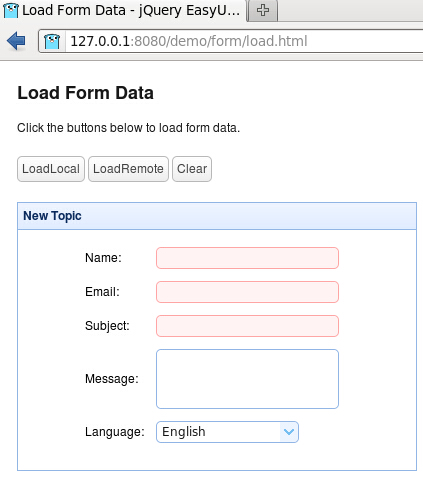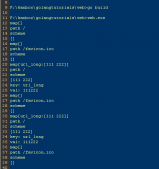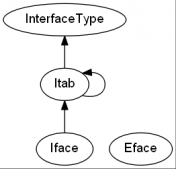Go 的设计是一种简单哲学,
它摒弃了其他语言一些臃肿的功能和模块,以降低程序员的学习门槛,减少使用中的心智负担。
本文,我们来探讨 Go 中缺失的数据结构:Set,以及它的最佳实现方案。
Set 语义与实现方案
Set 集合是其他语言中常见的数据结构。特性:集合中的对象不按特定的方式排序,并且没有重复对象。
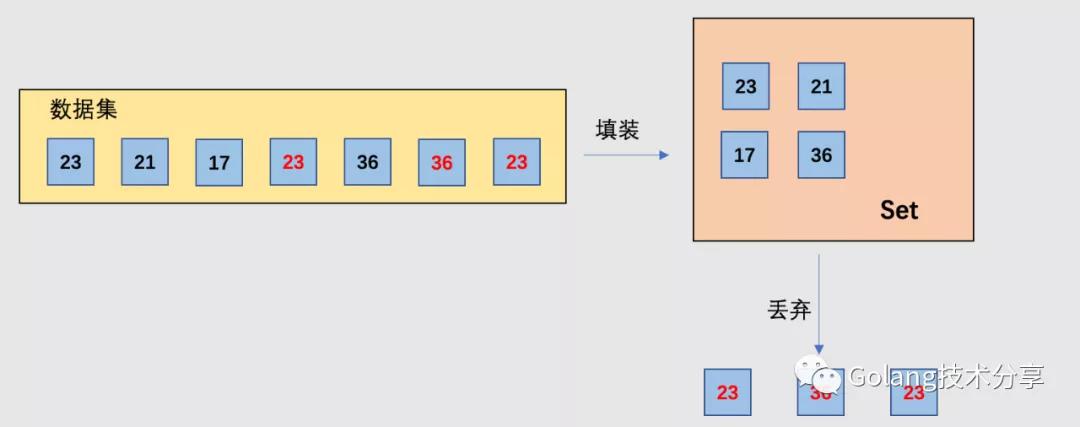
学习 Go ,要记住:Go 没有包含的东西,不代表 Go 真的没有。根据 Set 特性,我们可以很轻松地想到使用 map 的实现方案(因为 map 的 key 是不重复的):把对象当做 key 存入 map。
使用 map 来实现 Set,意味着我们只关心 key 的存在,其 value 值并不重要。有其他语言编程经验的人也许会选择 bool 来作为 value,因为它是其它语言中内存消耗最少的类型(1个字节)。但是在 Go 中,还有另一种选择:struct{}。
- fmt.Println(unsafe.Sizeof(struct {}{})) // output: 0
压测对比
为了探究哪种数据结构是作为 value 的最佳选择。我们选择了以下常用的类型作为 value 进行测试:bool、int、interface{}、struct{}。
- package main
- import (
- "testing"
- )
- const num = int(1 << 24)
- // 测试 bool 类型
- func Benchmark_SetWithBoolValueWrite(b *testing.B) {
- set := make(map[int]bool)
- for i := 0; i < num; i++ {
- set[i] = true
- }
- }
- // 测试 interface{} 类型
- func Benchmark_SetWithInterfaceValueWrite(b *testing.B) {
- set := make(map[int]interface{})
- for i := 0; i < num; i++ {
- set[i] = struct{}{}
- }
- }
- // 测试 int 类型
- func Benchmark_SetWithIntValueWrite(b *testing.B) {
- set := make(map[int]int)
- for i := 0; i < num; i++ {
- set[i] = 0
- }
- }
- // 测试 struct{} 类型
- func Benchmark_SetWithStructValueWrite(b *testing.B) {
- set := make(map[int]struct{})
- for i := 0; i < num; i++ {
- set[i] = struct{}{}
- }
- }
我们运行以下命令,进行测试
- $ go test -v -bench=. -count=3 -benchmem | tee result.txt
- goos: darwin
- goarch: amd64
- pkg: workspace/example/demoForSet
- cpu: Intel(R) Core(TM) i5-8279U CPU @ 2.40GHz
- Benchmark_SetWithBoolValueWrite
- Benchmark_SetWithBoolValueWrite-8 1 3549312568 ns/op 883610264 B/op 614311 allocs/op
- Benchmark_SetWithBoolValueWrite-8 1 3288521519 ns/op 883599440 B/op 614206 allocs/op
- Benchmark_SetWithBoolValueWrite-8 1 3264097496 ns/op 883578624 B/op 614003 allocs/op
- Benchmark_SetWithInterfaceValueWrite
- Benchmark_SetWithInterfaceValueWrite-8 1 4397757645 ns/op 1981619632 B/op 614062 allocs/op
- Benchmark_SetWithInterfaceValueWrite-8 1 4088301215 ns/op 1981553392 B/op 613743 allocs/op
- Benchmark_SetWithInterfaceValueWrite-8 1 3990698218 ns/op 1981560880 B/op 613773 allocs/op
- Benchmark_SetWithIntValueWrite
- Benchmark_SetWithIntValueWrite-8 1 3472910194 ns/op 1412326480 B/op 615131 allocs/op
- Benchmark_SetWithIntValueWrite-8 1 3519755137 ns/op 1412187928 B/op 614294 allocs/op
- Benchmark_SetWithIntValueWrite-8 1 3459182691 ns/op 1412057672 B/op 613390 allocs/op
- Benchmark_SetWithStructValueWrite
- Benchmark_SetWithStructValueWrite-8 1 3126746088 ns/op 802452368 B/op 614127 allocs/op
- Benchmark_SetWithStructValueWrite-8 1 3161650835 ns/op 802431240 B/op 613632 allocs/op
- Benchmark_SetWithStructValueWrite-8 1 3160410871 ns/op 802440552 B/op 613748 allocs/op
- PASS
- ok workspace/example/demoForSet 42.660s
此时的结果看起来不太直观,这里推荐一个 benchmark 统计工具:Benchstat。通过以下命令进行安装
- $ go get -u golang.org/x/perf/cmd/benchstat
使用 benchstat 分析刚才得到的 benchmark 结果文件
- $ benchstat result.txt
- name time/op
- _SetWithBoolValueWrite-8 3.37s ± 5%
- _SetWithInterfaceValueWrite-8 4.16s ± 6%
- _SetWithIntValueWrite-8 3.48s ± 1%
- _SetWithStructValueWrite-8 3.15s ± 1%
- name alloc/op
- _SetWithBoolValueWrite-8 884MB ± 0%
- _SetWithInterfaceValueWrite-8 1.98GB ± 0%
- _SetWithIntValueWrite-8 1.41GB ± 0%
- _SetWithStructValueWrite-8 802MB ± 0%
- name allocs/op
- _SetWithBoolValueWrite-8 614k ± 0%
- _SetWithInterfaceValueWrite-8 614k ± 0%
- _SetWithIntValueWrite-8 614k ± 0%
- _SetWithStructValueWrite-8 614k ± 0%
从内存开销而言,struct{} 是最小的,反映在执行时间上也是最少的。由于 bool 类型仅占一个字节,它相较于空结构而言,相差的并不多。但是,如果使用 interface{} 类型,那差距就很明显了。
所以,毫无疑问,在 Set 的实现中, map 值类型应该选 struct{}。
总结
本文虽然讨论的是 Set 的实现方案,但本质是涉及空结构体 struct{}{} 的 零内存特性。
空结构体除了是实现 Set 的 value 值最佳方案,它还可以应用于以下方面:
- 通知信号的 channel:当 channel 只用于通知 goroutine 的执行事件,此时 channel 就不需要发送任何实质性的数据,选择使用 chan struct{} 。
- 没有状态数据的结构体:当对象只拥有方法,而不包含任何的属性字段时,选择使用空结构体定义该对象。
原文链接:https://mp.weixin.qq.com/s/pcwCW7jtr2_CJ_k58He-6Q



